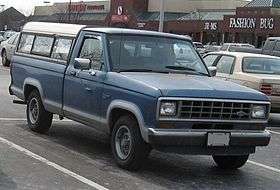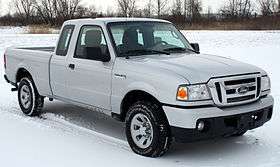Ford Ranger
The Ford Ranger is a nameplate that has been used on three distinct model lines of vehicles sold by Ford. Originally used from 1958 to 1960 by the short-lived Edsel division on its base-trim Edsel Ranger model line, the name was adopted between 1965 and 1981 on various versions of the Ford F-Series as a trim line and option package. For the 1983 model year, the Ranger name was given its own model line, becoming a compact pickup truck sold in North America and later, parts of South America.
Since 1998, Ford began to use the Ranger nameplate globally. The Ranger was discontinued in the United States and Canada for the 2011 model year,[1] while sales of an updated version continued in international markets throughout the 2012 to 2018 model years. As of the 2019 model year, Ford will resume sales of the Ford Ranger in the United States and Canada.
Americas (1983–Present)
For the 1983 model year, Ford introduced the Ford Ranger for the United States and Canada. Replacing the 1971-1982 Ford Courier (a rebadged Mazda B-Series), the Ranger was the first compact pickup truck designed by Ford Motor Company. In 1995, exports of the Ford Ranger began in select Latin and South American countries. To accommodate the demand for the vehicle, in 1998, Ford Argentina commenced local production of the Ranger, introducing a four-door cab not sold in North America.
Over its 29-year production, the Ford Ranger was produced over the same chassis architecture over three generations. Alongside a major redesign in 1993 and a smaller one in 1998, the model saw a mid-cycle update for 1989, with smaller updates in 2001, 2004, and 2006. For 2010, the South American version of the Ranger saw all-new exterior sheetmetal not given to its North American counterpart.
The Ford Ranger served as the basis for several models, including the Ford Bronco II compact SUV, the first two generations of the Ford Explorer mid-size SUV (alongside the Mazda Navajo and Mercury Mountaineer), and the first-generation Ford Explorer Sport Trac mid-size pickup truck. From 1994 to 2009, Mazda sold rebadged versions of the Ranger in the United States and Canada as the Mazda B-Series (the reverse of the rest of the world and the reverse of the original Mazda-sourced Ford Courier).
On December 22, 2011, the final Ford Ranger produced for North America rolled off the assembly line, becoming the final vehicle assembled at Twin Cities Assembly.[2]
For the 2012 model year, Ford Argentina began assembly of the Ford Ranger T6.
United States (2019)
For the 2019 model year, Ford commences sales of its own version of the global Ford Ranger, after an eight-year hiatus of the nameplate. The first generation of the Ranger sold as a mid-size pickup truck in the United States and Canada, the new generation features a strengthened frame and front bumper. Ford will sell a SuperCab and SuperCrew (for the first time), whereas a version of the two-door standard cab will not be available.
As the compact Ranger served as the basis for several other Ford vehicles during its production, the 2019 Ranger will serve as the basis for the 2020 Ford Bronco mid-size SUV.[3]
 First generation (1983-1988)
First generation (1983-1988) First generation facelift (1989-1992)
First generation facelift (1989-1992) Second generation (1993-1997)
Second generation (1993-1997) Third generation (1998-2000)
Third generation (1998-2000) Third generation third/final facelift (2006-2012)
Third generation third/final facelift (2006-2012) South America, facelift (2010-2012)
South America, facelift (2010-2012) Fourth Generation revived Ford Ranger. (2018-Present)
Fourth Generation revived Ford Ranger. (2018-Present)
International (1998–present)
For markets outside of North America, Ford badge engineered the Japanese-built Mazda B-Series as the Courier starting in 1971, renaming it the Ranger in 1998 (with the exception of Australasia where the Courier nameplate was retained until 2006; incidentally the Courier was also sold in North America prior to the 1983 model year). Second-generation Ranger models from 2006 to 2011 were also designed by Mazda, being rebadged versions of the successor to the B-Series, the first generation BT-50.
Third-generation models, as produced since 2011, were designed and engineered by Ford Australia, with this time the Mazda badged variant being the derivative version of the Ford, offered as the second generation BT-50. This third generation is also the basis for the Ford Everest SUV and therefore, the Ranger and the Everest share a number of features. Third generation Ford Ranger and particularly its most expensive flagship version (the Ranger "Wildtrack"), has vastly increased its presence on the European market, making the Ranger the best selling pickup truck in Europe by 2015.
For the 2019 model year, the Ranger T6 commences sales in North America, with several external and internal changes to adapt to government regulations and market demands.
_vehicles_-_geograph.org.uk_-_1544030.jpg) 1998–2002
1998–2002 2002–2006
2002–2006 2006–2009
2006–2009_%E2%80%93_Frontansicht%2C_10._September_2011%2C_D%C3%BCsseldorf.jpg) 2009–2011
2009–2011_XLT_High_Rider_4-door_Super_Cab_utility_(2012-07-14).jpg) 2011–2015
2011–2015_XLT_4WD_4-door_utility_(2018-07-19)_01.jpg) 2015–present
2015–present
References
- ↑ "Ford Ranger - Overview". Detroit Auto Press. Retrieved 27 May 2018.
- ↑ Max, Josh (19 December 2011). "Ford Ranger, other cars, cease production in 2012". New York Daily News. Retrieved 26 December 2014.
- ↑ Ford NAIAS 2017: Official Press Conference Livestream
| Wikimedia Commons has media related to Ford Ranger. |